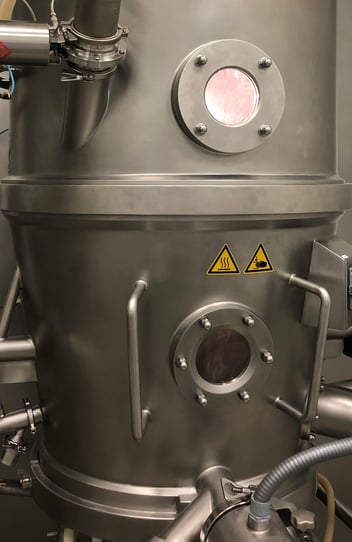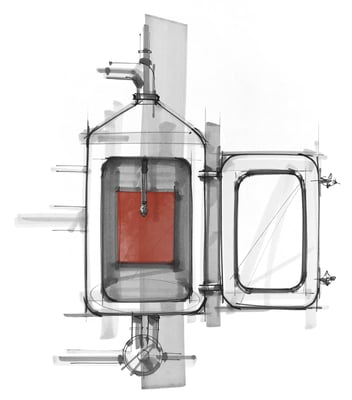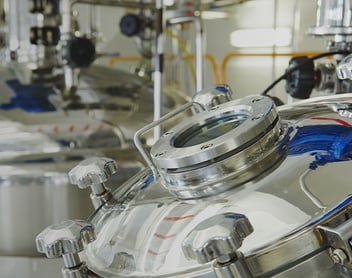Pharmaceutical CIP Cleaning Made Easy
Does your pharmaceutical or nutraceutical company struggle with CIP? Are foaming, wastewater disposal, or product residues left on equipment causing equipment downtimes? These are all issues resulting from the use the wrong cleaning CIP process. Using the correct CIP process, a properly designed CIP system, and the correct cleaning detergent, however, will help you avoid these issues and make pharmaceutical CIP cleaning easy. Before examining these topics, let’s discuss the history of CIP, and examine how to find and develop the right cleaning detergent.
BACKGROUND OF CIP CLEANING
Before Clean in Place (CIP) emerged as a cleaning option for the pharmaceutical industry, equipment was dismantled and manually cleaned with chemicals and brushes. Caustic chemicals were typically the cleaning agent of choice because of their effectiveness. Due to the nature of manual cleaning, companies experienced
high labor costs and long equipment downtimes associated with the time spent disassembling equipment, scrubbing soiled areas, and reassembling equipment. In the early 1950s, CIP was introduced and changed the manner in which equipment was cleaned. The CIP Process refers to the use of a mix of chemicals, spray action, and heat to clean machinery, vessels, and pipes without dismantling equipment. The CIP process may include pre-rinse, chemical re-circulation, intermediate rinse, sterilant, and post-sterilant rinse. Since its inception, the CIP process has evolved and improved. Overall, CIP stands as the most effective and efficient way of cleaning equipment.
In modern CIP, pharmaceutical and nutraceutical industries typically use single-pass CIP. The method targets heavy soils. The pharmaceutical industry specifically uses the single-pass process to clean APIs, excipients, haze, and tablet coatings from equipment.
The single-pass cleaning process for pharmaceutical CIP has significantly improved since its introduction. It now benefits companies by lowering the cost of CIP processes and reducing labor expenses, and by increasing equipment uptimes and enhancing productivity.
The pharmaceutical and nutraceutical industries, nonetheless, continue to face other CIP cleaning challenges that include:
1. Foaming and subsequential pump cavitation
2. Meeting wastewater regulations after going straight to drain
3. Using the wrong detergent for your CIP process
The following segments of this article address these common Pharmaceutical CIP challenges and reveal simple, effective, and modern solutions.
Dealing with over foaming and pump cavitation
Over-foaming and pump cavitation stand as a significant problem for the CIP process. Over-foaming results from using the wrong combination of detergents or from using a detergent at too low of a temperature. This typically leads to foaming that negatively impacts proper pump functionality and, as a result, impedes the CIP
process. The key to successfully avoiding over-foaming results from using the right combination of surfactants and detergents at specific cleaning temperatures. This approach avoids the need to re-clean while reducing equipment downtime, increasing productivity, and minimizing wasted monetary resources.
Meeting wastewater regulations
Over the past several decades, highly polluted wastewater has negatively impacted the environment. As a result, environmental regulation and laws have been enacted to combat environment-damaging industrial pollution. Polluted wastewater disposal acts as a major environmental challenge for the pharmaceutical and
nutraceutical industries. Currently, wastewater must meet specific pollution levels before it may be disposed of into a municipal wastewater system. Using a poorly designed CIP system, in conjunction with an all-purpose detergent, results in excess chemicals remaining in wastewater. This causes unnecessarily high wastewater treatment and management costs, and increased wastewater disposal expenses.
Using the wrong detergent
The overarching issue that complicates CIP design and detergent issues stem from the fact that you cannot clean any soil with any detergent while expecting your equipment to be clean. Consequently, all cleaning detergents do not clean equally. An off-the-shelf, multipurpose detergent that cleans any and all soils does not exist at this time. Using a multipurpose cleaning approach results in partially cleaned equipment.
What does this all mean? When surfactants in detergents do not grab specific soils and remove them, equipment remains soiled and must be re-cleaned. To effectively solve this issue, the cleaning process and detergent used must be analyzed, and chemical ingredients must be adjusted to target and clean specific soils and APIs. Otherwise, ineffective cleaning yields hazes and residues, and creates the need to re-clean equipment in order to remove soils and pass validation tests. Hence, a custom-formulated detergent targets soils, maximizes your CIP equipment’s capabilities, results in clean equipment, and saves your company money.
The science of cleaning has evolved since Cleaning-in-Place (CIP) was invented. The process is now seeing extraordinary innovations arise in the form of custom-formulated detergents that are cost-effective, remove all soils, and result in clean equipment.
These optimally formulated CIP detergents enhance the CIP process by offering you and your company the following benefits:
1. Minimized Equipment Downtime
2. Maximized Use of Assets
3. Ensured Worker Safety
4. Easily Achieved Validated State
We all know that the cleaning process involves a monetary investment in your CIP system and that a properly designed CIP system allows for a controlled CIP process. Not all cleaning detergents, however, deliver equal results because multipurpose detergents do not clean all soils. On the other hand, a custom formulated CIP detergent fully cleans equipment by maximizing the potential of the CIP processes and by targeting the APIs and other soils. Therefore, targeted cleaning with a custom-formulated detergent results in the removal of all soils and drastically improves validation test results.
Dober works with you to not only develop a custom cleaning solution that helps you remain cGMP compliant, but, more importantly, to provide you with the right cleaning detergent that removes the full soil. Dober and their cleaning experts create custom, effective CIP cleaning solutions to help you meet the needs of your company. Our experts will recommend a custom-formulated detergent for your cleaning needs and help develop a process that will optimize your CIP cleaning program.
Contact Dober today for a FREE cleaning evaluation. Let’s make CIP cleaning easy.




